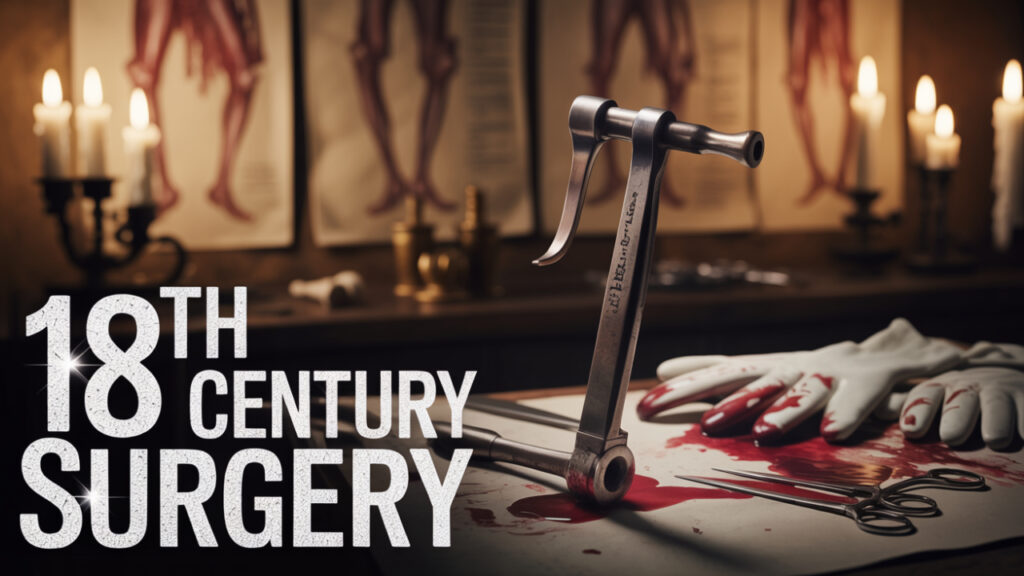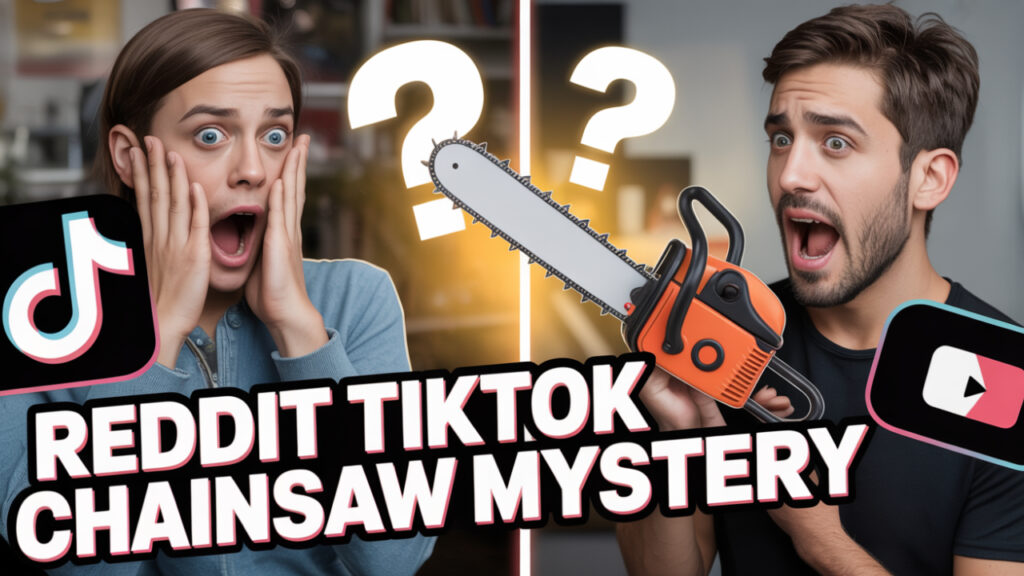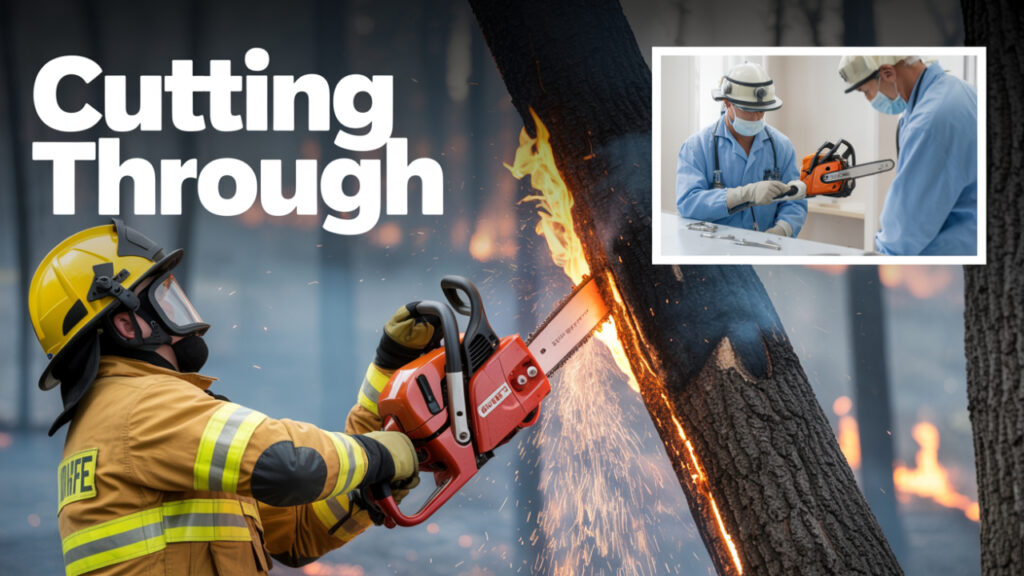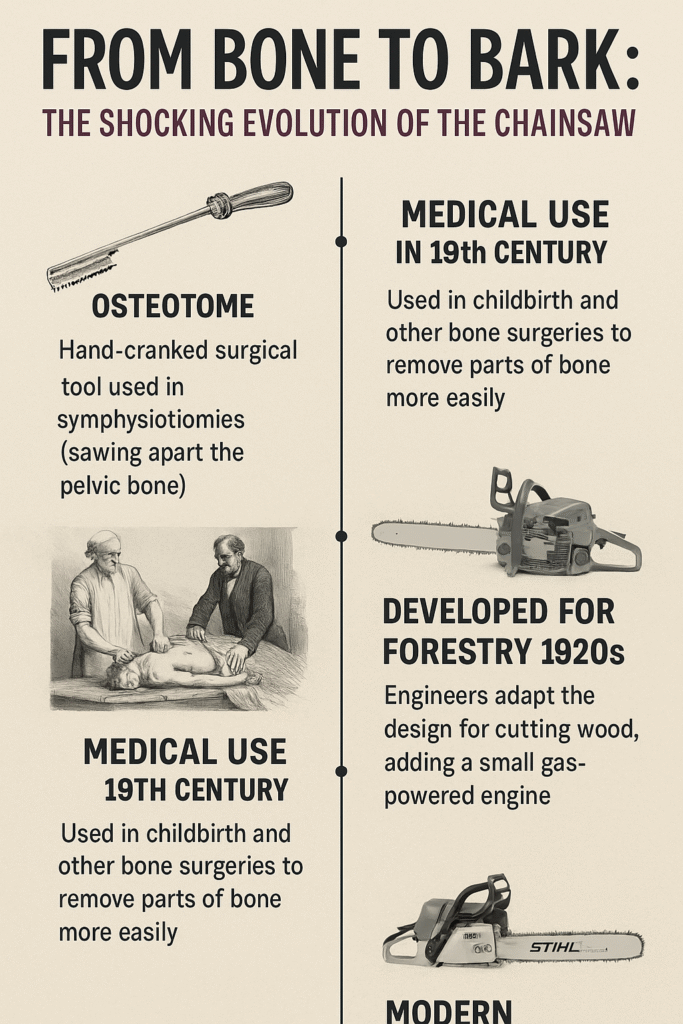Published on May 18, 2025 • Last Updated on May 18, 2025
Imagine you’re strapped to a wooden table in the 1700s, no anesthesia, and the doctor pulls out… a chainsaw. 😱 Sounds like a horror movie, right?
But this isn’t fiction. The first chainsaws weren’t made for cutting trees — they were designed for childbirth.
Yes, childbirth.
This brutal, bone-slicing tool has a backstory so wild, it flips everything you thought you knew about medicine, history, and horror.
…and that’s just the beginning.
⚡ TL;DR
- Chainsaws were originally invented to assist in childbirth — not for cutting wood.
- Two Scottish doctors created the first version in the 18th century to perform a surgical procedure called symphysiotomy.
- This device was later adapted for tree cutting, sparking the birth of modern forestry tools.
- And that’s not even the weirdest part.
⏳ The Bone-Crunching Birth of the Chainsaw

Before it was the weapon of choice in horror movies or a staple in every lumberjack’s toolkit, the chainsaw had a far more gruesome origin — the delivery room.
The Year Was 1780
In a time before epidurals or safe cesareans, childbirth could turn deadly in an instant. If a baby was stuck in the birth canal — especially shoulder-first or breach — doctors had to act fast. One extreme method was symphysiotomy, a procedure that involved sawing through the pelvic bone to widen the birth canal.
Yes, sawing. Through living bone. Without anesthesia.
Absolutely horrifying.
Enter the Inventors: John Aitken & James Jeffray
Two Scottish surgeons — Dr. John Aitken and Dr. James Jeffray — sought to make the process “more efficient.” So they invented a small, hand-cranked rotating saw with teeth on a chain. It looked like a pocket-sized torture device — and in many ways, it was.
Instead of using a regular saw or knife (which risked jagged fractures and horrific outcomes), this new tool allowed for a “cleaner” cut. Quicker. Sharper.
But not less terrifying.
The First Chainsaw Was…Tiny?
It was called an osteotome — a handheld device resembling a modern-day kitchen knife with a chain on it. Cranked by hand. No gas. No roar. Just cold metal and bone.
And here’s the real kicker…
This medical chainsaw was used for decades — not just in childbirth, but also in amputations and other surgeries.
And it didn’t stop there…
🎭 From Horror to Hardware

If you’re thinking, “Okay, so some 18th-century doctors built a medieval torture device — big deal,” here’s why it is a big deal:
The chainsaw is a rare example of a medical invention that became a hardware icon.
It’s not just about its gruesome origins — it’s about how we normalize tools with violent pasts.
From Sawing Pelvises to Felling Pines
In the early 1900s, as industrialization exploded and lumber became a booming business, engineers saw potential in the rotating chain-and-tooth design. What was once used to saw human bone was scaled up to saw wood — fast.
By the 1920s, companies in Germany and the U.S. began producing gas-powered chainsaws for forestry.
The design was eerily similar: chain, teeth, power source — just bigger, louder, and no longer for slicing humans.
The Irony We Don’t Talk About
Here’s the wild twist: The chainsaw’s mechanical “DNA” hasn’t changed much in 200+ years.
What began as a solution to a childbirth crisis became a symbol of raw power, masculinity, and destruction.
You’ve seen it in horror movies. In survival shows. In memes.
But few realize they’re watching the descendant of a surgical tool meant to cut through mothers’ pelvises.
And that bizarre duality?
It says a lot about how society compartmentalizes pain, progress, and history.
But wait until you hear what got buried in the official story…
🔥 Buried Truths: The Chainsaw Controversy No One Talks About

Chainsaws are often glamorized — by loggers, survivalists, even pop culture.
But buried beneath that roaring engine is a disturbing medical controversy that’s still impacting lives today.
Symphysiotomy Didn’t End — It Was Just Hidden
While many believe symphysiotomies ended with the invention of safer cesarean sections, they didn’t.
In fact, some hospitals in Ireland continued performing the procedure without consent well into the 1980s.
Let that sink in:
The same bone-slicing technique that inspired the chainsaw was quietly used on thousands of women…
Often without their knowledge. Without anesthesia. Without choice.
The Scars Run Deep — Literally and Figuratively
Women who endured the procedure report lifelong complications:
- Chronic pain
- Difficulty walking
- PTSD
- Incontinence
- Broken trust in medical systems
In 2014, the Irish government offered limited compensation to survivors — but many saw it as hush money, not justice.
The Catholic Church’s influence, medical secrecy, and systemic misogyny all played a role.
So when we talk about chainsaws, we’re not just talking about hardware or horror movies…
We’re talking about a legacy of pain that was medicalized, minimized, and monetized.
And some experts say we’ve only scratched the surface…
💡 Theories & Viral Takes: Why the Internet Is Obsessed With Chainsaws’ Dark Origin

Once people find out chainsaws were invented for childbirth, the internet does what it does best:
It spirals. And some of the interpretations out there?
Downright unhinged… but strangely compelling.
Reddit’s Take: “Medicine or Medieval Torture?”
In countless Reddit threads, users debate whether the early medical community was innovative… or just brutal with better PR.
One upvoted comment reads:
“They didn’t invent a chainsaw to save women — they invented it to protect the doctor’s hands from slipping on the bones.”
Ouch.
Others dig into the symbolism of power tools and how a device originally used on women’s bodies became a symbol of masculine dominance in pop culture.
TikTok’s Take: “Tell Me Again Why You Trust Doctors?”
Medical TikTok exploded with reactions to this story. Creators stitched shocked reactions with photos of the original osteotome, calling it:
- “The most cursed invention in medicine”
- “Proof the patriarchy invented power tools”
- “Why I flinch every time I hear a chainsaw in the woods”
One viral video with over 3 million views starts with:
“POV: You’re giving birth in 1780 and the doctor pulls this out.”
Yeah. It hits different.
Historians: “This Is What Happens When We Erase Women’s Pain”
Academic takes are just as damning. Medical historians argue that the original chainsaw represents:
- The normalization of pain in women’s healthcare
- A time when speed was valued over safety or consent
- The early roots of mechanizing the human body
Some even suggest the evolution of the chainsaw reflects a broader trend:
Turning human suffering into profit and progress.
But the weirdest part?
We still carry that legacy — in every buzz, every tree felled, every chainsaw-wielding movie villain.
And it doesn’t stop with history…
🚀 From Surgery to Survival: The Legacy Chainsaws Left Behind

Chainsaws didn’t just switch industries — they became icons.
And their evolution says more about human progress, survival, and irony than almost any tool on Earth.
The Timber Boom: When Trees Became Targets
By the 1920s, chainsaws were redesigned, gas-powered, and ready for the forest.
Suddenly, what once sliced pelvic bone was felling centuries-old trees in seconds.
This led to:
- Rapid expansion of logging industries
- Increased deforestation across North America and Europe
- The rise of “lumberjack culture” — flannel, axes, and… a chainsaw
Chainsaws became a symbol of control over nature — raw, loud, unstoppable.
The Movie Monster Era
Then came The Texas Chainsaw Massacre (1974), and everything changed.
Now, the chainsaw was more than a tool — it was a weapon of fear.
In pop culture, it represented:
- Chaos
- Madness
- Visceral, unstoppable violence
All stemming from a device originally meant to help save lives.
That’s the twist: The chainsaw went from surgery to survival… then to cinema’s most twisted killer.
Modern Use: Still a Lifesaver
Chainsaws are now used in:
- Disaster relief (clearing debris after hurricanes or earthquakes)
- Search and rescue
- Firefighting in wildland settings
- Sustainable forestry practices
Ironically, the tool once used to slice bone is now saving lives in collapsed buildings and burning forests.
And Yet… the Echoes of Its Origin Remain
Even as chainsaws serve noble purposes today, their origin story lingers — just beneath the surface.
Because no matter how much we upgrade the tech, one truth remains:
The chainsaw was born from desperation, pain, and the need to control the uncontrollable.
And its roar?
It still sounds a little too much like a scream.
📺 See the Shocking Origins for Yourself
Before we go further, you have to see this.
This short documentary breaks down the chainsaw’s disturbing history — including real surgical tools and survivor testimony.
Trigger warning: This isn’t easy to watch.
But it’s the kind of video that leaves you saying, “How did I never know this?”
Still think chainsaws are just for trees?
Let’s keep going…
😈Maybe It Wasn’t About Birth At All

Here’s a question nobody’s asking:
What if the chainsaw wasn’t invented to help women… but to help doctors?
Let’s be blunt — symphysiotomy didn’t prioritize mothers.
It prioritized speed, surgical ease, and the doctor’s convenience.
Think about it:
- No anesthesia
- No consent
- No follow-up care
And the chainsaw? It made things faster — for the doctor, not the patient.
Pain was expected. Trauma was ignored. Scars were “part of the process.”
Even today, women’s pain is underrated in medicine.
So what if the chainsaw’s invention wasn’t just a medical breakthrough…
What if it was the industrialization of suffering?
A sign that tech always reflects who has power — and who doesn’t.
Downloadable Timeline – The Evolution of the Chainsaw

Want a visual breakdown of this jaw-dropping history?
Download our exclusive PDF:
🪚 From Bone to Bark: The Shocking Evolution of the Chainsaw
Includes:
- 1780 osteotome design sketch
- Timeline of surgical to industrial adaptations
- Comparison of medical vs. modern chainsaw specs
- Case study summary from Ireland’s symphysiotomy survivors
📥 [Download the Chainsaw History Timeline PDF]
Use it for school, storytelling, or just to blow your friends’ minds. Here’s a chainsaw invention timeline from STIHL.
🧠 The Final Cut: What It All Means

So, next time you hear a chainsaw roar, ask yourself: Is that the sound of progress… or a scream echoing from the past?
This tool — born in the bloodied shadows of medicine — now clears forests, saves lives, and haunts horror movies.
But its twisted legacy lives on in every tooth of the chain.
If this blew your mind, check out our article on [tools with dark origins] and see what other inventions have buried pasts.
And don’t forget to grab the downloadable timeline — it’s worth framing.
❓ FAQs
Were chainsaws really invented for childbirth?
Yes. The original chainsaw, called an osteotome, was created by Scottish doctors in the 1780s to cut through pelvic bone during childbirth procedures known as symphysiotomies.
What is a symphysiotomy?
It’s a surgical procedure that widens the pelvis by cutting the cartilage or bone. It was used before safe cesarean sections existed — often without anesthesia or consent.
When did chainsaws become tools for cutting wood?
In the 1920s, engineers adapted the medical concept into larger, gas-powered tools used in the logging industry. The design transitioned from human surgery to tree surgery.
Why is the chainsaw associated with horror movies?
Thanks to films like The Texas Chainsaw Massacre, the tool became a cinematic symbol of unstoppable, brutal violence — which ironically ties back to its medical roots.
Are chainsaws still used in medicine today?
No. Modern surgery uses precise instruments and imaging. Chainsaws are now reserved for forestry, rescue operations, and emergency response — not human bone.

Seesii Mini Chainsaw Cordless 6-inch (w/ 2 Batteries + Case)
Compact, powerful, and beginner-friendly — this electric mini chainsaw is perfect for backyard pruning, wood cutting, and trimming. Comes with 2 batteries, safety gloves, and a durable case.
⭐️⭐️⭐️⭐️☆ 4.5/5 rating from 9,100+ buyers
💼 Tools You’ll Actually Use
These are trusted platforms we personally use and recommend. They can help you level up your listening, freelancing, or online privacy.
🔒 This post contains affiliate links. If you click and buy, we may earn a small commission — at no extra cost to you. Thanks for supporting the site!

John Green is the founder of OwlRatings.com, where he reviews and ranks the best products to help smart shoppers make informed decisions. With years of experience in content strategy, consumer research, and SEO, John specializes in turning complex comparisons into clear, trustworthy guides. When he’s not analyzing gear, you’ll find him deep in a rabbit hole of emerging tech or brewing a perfect cup of coffee.







